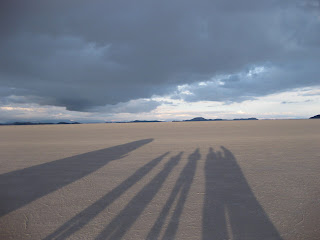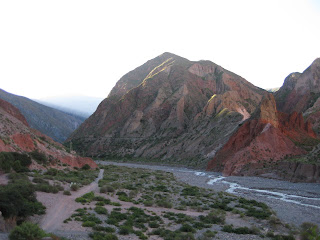

In Tupiza we met Barbara, a U.S. woman lately living in Paris but for the past year living on the road, and Deborah from Wigan, UK. Along with Kris, the 5 of us went in on a 4-day jeep trip through the weird and wonderful landscape between Tupiza and Uyuni.



Alfredo was our driver and his wife, Marleny, prepared the meals. They are such kind people and work so hard, away for days at a time from their 6-year-old son Dylan. They both talked about never having been able to study since they had to earn money. They were always smiling and enjoyed sharing information about what we were seeing as well as lots and lots of music. Alfredo (and his 11 siblings!) are from the Chaco region of the country and Mike and I both loved the Chaco folk music. Marleny definitely prefers clubby dance music.


The trip was mainly sitting in the jeep with stops for photos and meals. We drove through beautiful volcanic landscape dotted with herds of llama and vicuña and many small mudbrick villages and quinoa fields. I love that the llamas' herders mark them with bright woolly pompoms on the tips of their ears. One ghost town we walked through had many of our chinchilla-like friends the vizcachas playing in the snow.











We passed a number of lakes, one very green lake called Laguna Verde is concentrated with arsenic and magnesium and cannot support life. Another called Laguna Colorada was crowded with flamingoes. The algae and iodine in this lake give the water a red color that is most apparent in full sun. We saw it under clouds, but the flamingoes were as pink as ever. The volcanic activity all around this area also created great pools of boiling mud, sulfurous geysers and hot springs. After taking a dip in the last of these Mike said it sounded like a London pub after work.







The most remarkable thing we saw was the Uyuni salt flat, 12,000 square kilometers in area. It is flat and white and goes on and on. We headed there early in the morning for the sunrise, which happened behind the clouds while Alfredo was changing our flat tire. We climbed around among the cactus on the Isla del Pescado, which must have been a real island when water covered the area, and then took silly perspective-bending photos. Water runs under the salt and in places breaks through the surface in ojos. From these, Alfredo and Marleny pulled out giant salt crystals.











We stopped for a tailgate lunch each day, and then for dinner and sleep at several mudbrick hospedajes along the route. Our last evening we stayed near the Uyuni salt flat in an hospedaje built of salt bricks, with salt brick furniture and coarse salt covering the floor. A poster of El Presidente presided over our dinner table.




Now we are in Potosí and tomorrow will descend for a tour of the mines that honeycomb Cerro Rico, the mountain and silverlode that defined the colonial life of this city.






















